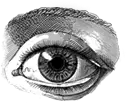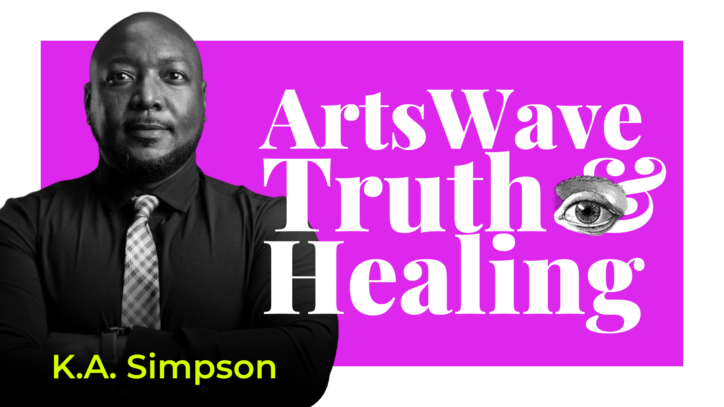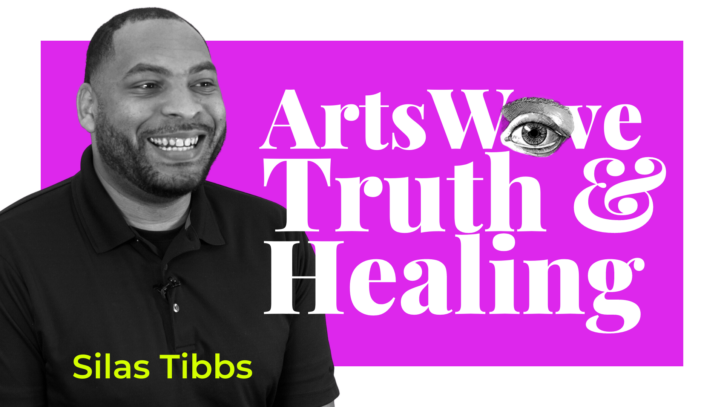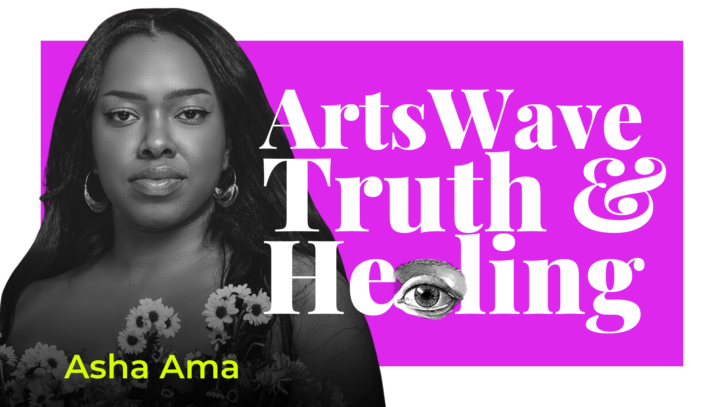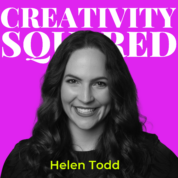
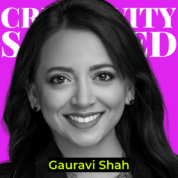
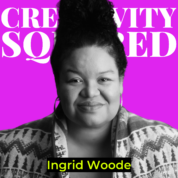



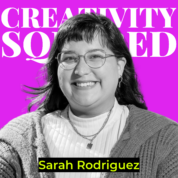
Ep57. ArtsWave “Truth & Innovation” Part 1: Gauravi Shah & Tatiana Godfrey, Ingrid Woode, Faith Marie, Lisa Merida-Paytes, Emily Hanako Momohara & Sarah Rodriguez
For the second year, Creativity Squared is proud to share a special series with the nation’s largest community arts campaign and our partner, ArtsWave. This year’s Truth & Innovation Artist Showcase centers around visual art, film, dance, and music by 22 of the region’s leading Black and Brown artists.
You can still see some of the works:
- This year’s “Visual Arts Exhibition” is open through August 8 at the Clifton Cultural Arts Center.
- The “Be Still” city-wide augmented reality portrait exhibition is available to experience through September 22
- The sketch comedy variety show, “Up the As*pirin: Pain Management,” takes place this coming Friday, July 26, and Saturday, July 27, at the Know Theatre of Cincinnati.
- As the Resident Playwright, Derek Snow will debut his play, ‘The Ravenside Occurrence,’ this September at Playhouse in the Park: https://www.cincyplay.com/tickets/Arts-Culture-Incubator.
Last year, eighteen of the Cincinnati area’s artists of color showcased their multidisciplinary works exploring the concepts of healing, rebirth, and reconnecting in the Truth & Healing ArtsWave showcase. Creativity Squared sat down with the 2023 artists to discuss their individual works for the series.
The intention of these interviews was, and is again this year, to give these artists another platform to share their art and the truth expressed through it, as you never know what ripples will turn into waves.
Creativity Squared is proud to share this special three-part series with our partner ArtsWave highlighting the phenomenal artists and grant recipients selected for this year’s ArtsWave Black and Brown Artist Program!
Today’s podcast focuses on the vision of five visual artists and two comedians for the world they want to live in and is expressed through their art. You’ll hear about:
- “Up the As*pirin: Pain Management” by Gauravi Shah & Tatiana Godfrey
- “Be Still” by Ingrid Woode
- “HeartSpace Poetry Project” by Faith Marie
- “Flow:Flux” by Lisa Merida-Paytes
- “Mother’s Tongue” by Emily Hanako Momohara
- “PatchWORK” by Sarah Rodriguez
They all talk about their individual projects and how it fits into this year’s theme: Truth & Innovation. The video interviews are also available on this YouTube Playlist. Check out Part 2 with the filmmakers and Part 3 with the live performance artists.
Who Is ArtsWave?
ArtsWave is a nationally recognized non-profit that supports over 150 arts organizations, projects, and independent artists. Because it’s important to support artists, 10% of all revenue generated from Creativity Squared goes to ArtsWave to support their Black and Brown Artists Program. The mission of Creativity Squared is to envision a world where artists not only coexist with A.I., but thrive.
The Black and Brown Artists Program supports independent artists of color in the greater Cincinnati area with direct grants of $10,000 each, as well as opportunities for mentorship, business skills training, and networking. Funded artists were selected by a panel based on how their proposal addressed this year’s showcase theme: “Truth & Innovation.”
And in case you missed it (or want to revisit it), listen to Episode 9 of Creativity Squared featuring Janice Liebenberg who served as the Vice President of Equitable Arts Advancement at ArtsWave to hear her talk about how the arts can bring people together and for more on ArtsWave.

Truth & Innovation Showcase
The ArtsWave Black and Brown Artist Program Showcase, now in its fourth year, supports local BIPOC artists and their interpretations of contemporary themes.
Artists present their works across multiple genres, exploring the modern BIPOC experience and the concepts of “Truth” and “Innovation.” Community collaboration is a key component of these projects, promoting a more equitable future for Cincinnati.
The showcase includes visual art, music, film, theater, dance, and more, representing the diverse experiences of underrepresented groups in modern America. For more details and event schedules, visit artswave.org/truth.
“Up the As*pirin: Pain Management” by Gauravi Shah & Tatiana Godfrey
“Maybe I can make an impact, maybe I can be impactful because it’s not so serious, it’s not so daunting and I love the ability of comedy to be hitting on truth without making it seem preachy.”
– Gauravi Shah
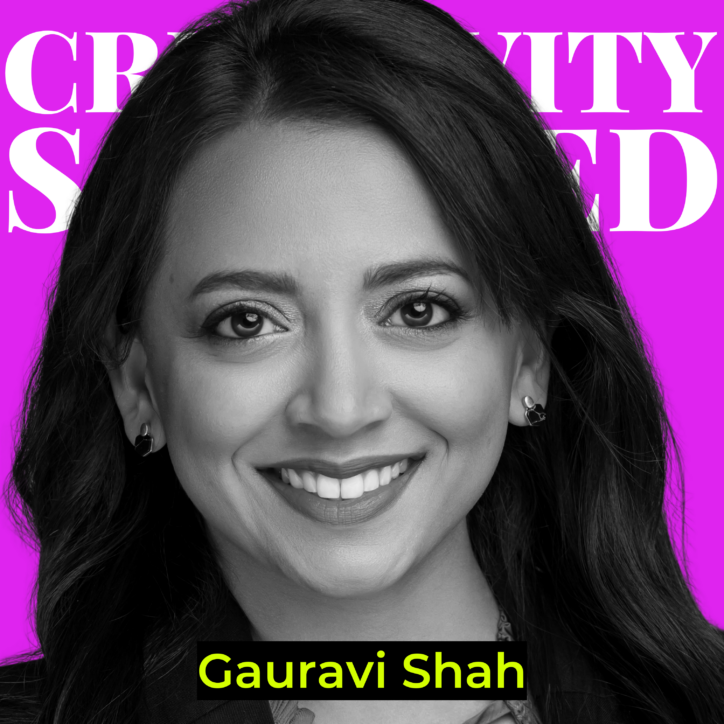
“Up the As*pirin: Pain Management” will feature a collection of sketches, music and other performance acts, developed, written, directed and performed by a team of Cincinnati comedians of color and allies. The acts will focus on the experiences of people of color and will address issues related to innovation, health, immigration and identity.
Meet Gauravi Shah, a renaissance woman of many talents: sustainability leader, nuclear engineer, chef, Jeopardy! champion, and comedian. Transplanted from Toronto five years ago, Gauravi’s comedy training includes The Assembly, Bad Dog Theatre and the Second City Conservatory – where she wrote and performed in the hit sketch revue Fake It Till You Make It. Locally, Gauravi has directed the touring musical improv troupe Hot Mic and has coached all levels of improvisational and sketch comedy for Improv Cincinnati, where she was a company member. She directed their sold out holiday shows Elfish and It’s a Holiday Show. She also produced and directed the hit Troof and Sketchconciliation as a 2021 recipient for the Truth and Reconciliation Artswave grant. She is passionate about furthering the role of comedy in theatre and promoting inclusivity through diversity initiatives to encourage people of colour and women in the arts.
“Be Still” by Ingrid Woode
“I’m a musician first. And what I’ve learned as a musician and in telling stories that — like I don’t call myself a pianist, I don’t call myself a videographer, those type of things — they’re tools that I use to execute an idea.”
– Ingrid Woode

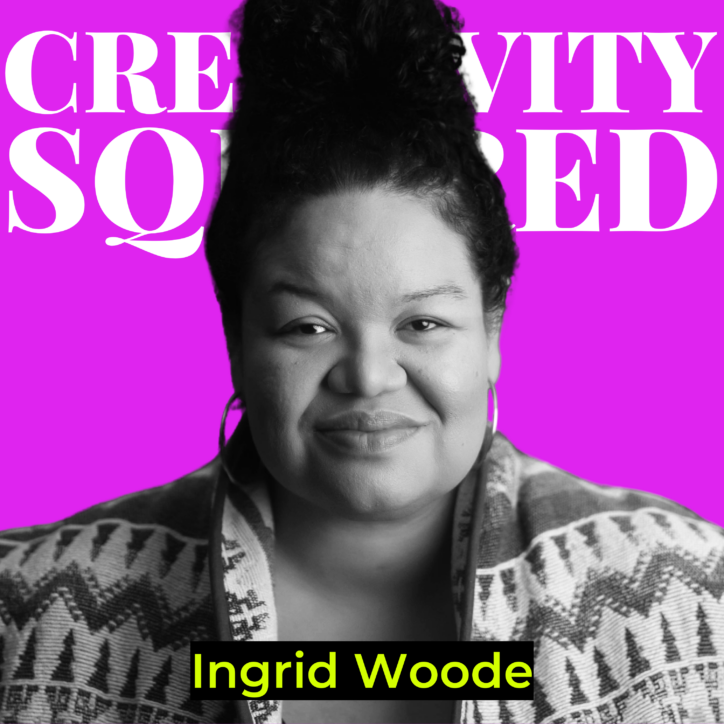
Be Still is a multimedia portrait series highlighting accountability in mental and emotional health. Consisting of photographic portraits, video portraits, 3D portraits in virtual reality and a musical score, the project will include portraits of 7-10 Cincinnatians to spark dialogue around mental and emotional health.
Meet Ingrid Woode, a versatile musician and visual storyteller who leaves an indelible mark through her multimedia artistry. Her portfolio extends beyond music to photography and filmmaking. With a passion for visual storytelling, she has produced short documentaries and docuseries that captivate and inspire. Ingrid Woode’s journey is a testament to the boundless possibilities of creativity. Her mediums are as diverse as her talent, including music, photography, video, and digital art.
“HeartSpace Poetry Project” by Faith Marie
“My truth that is expressed through this piece is that I am an angry Black woman. And I don’t think that I’m alone in being an angry Black woman, I don’t think I’m alone and being an angry woman, an angry feminine person.”
– Faith Marie
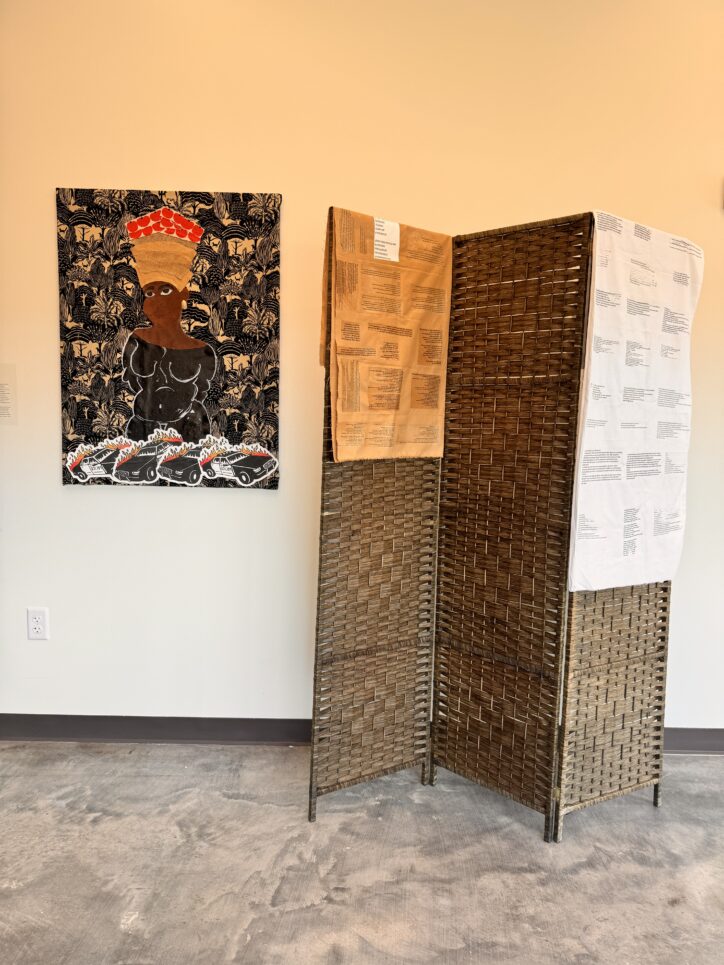
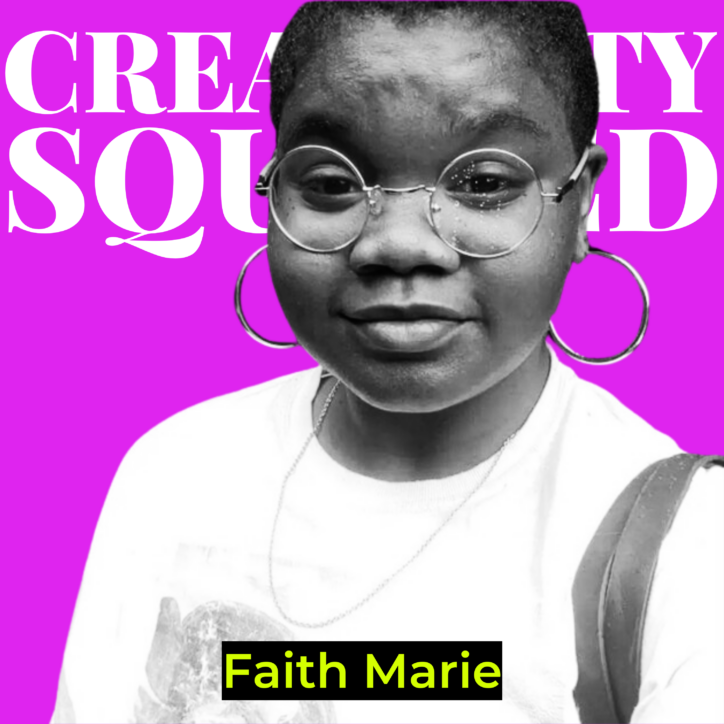
The HeartSpace Poetry Project will be a digital archive of poetry created through an 8-week writing program for high school girls between ages 14-18. The project will empower young minds to express themselves, engage with their community, and foster understanding of place, shared experiences and identity.
Meet Faith Marie, who was born and raised in Dayton and currently resides in
Cincinnati, OH. She holds a B.A. in Women’s, Gender, and Sexuality Studies, as
well as Master’s-level education in Public Health from the Ohio State University. With a strong focus on leveraging art and nature to deepen self-awareness, well-being, and access to justice, Faith is deeply passionate about engaging these domains as valuable sources of knowledge. She believes language is a form of empowerment and conscious raising. Her poetic form focuses on personhood, heritage, and observation. She has performed at open mics and community events including the 2023 Juneteenth Festival in Cincinnati and the 2023 National Underground Freedom Center. Faith Marie has also completed a performing art apprenticeship with Artwork V2 Gallery in September 2023.
She brings a unique blend of health and wellness programs aimed at fostering learning and active participation, while cultivating a platform for individuals of color to explore their creativity and ignite meaningful conversations. She was initiated as a visual artist in 2020 after her grandmother’s passing which led to her explorations of identity, mental health, and ancestry.
“Flow:Flux” by Lisa Merida-Paytes
“My truth is bringing awareness of someone that might be experiencing some sort of malfunction or some metamorphosis in their body or their work or their world.”
– Lisa Merida-Paytes
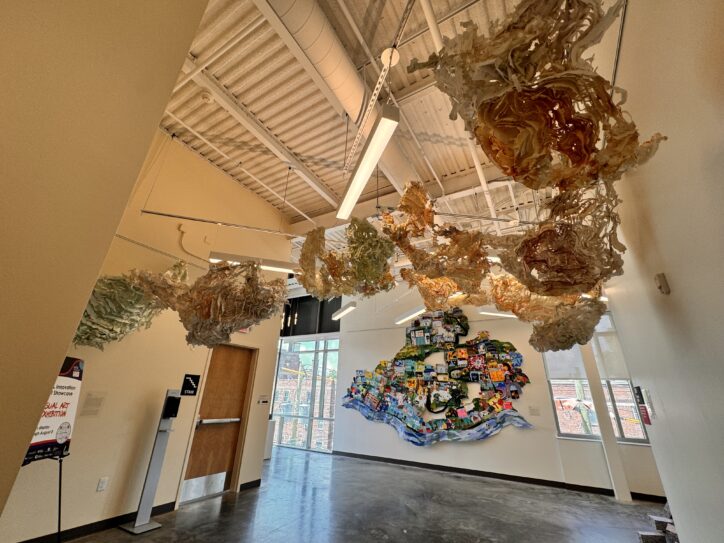
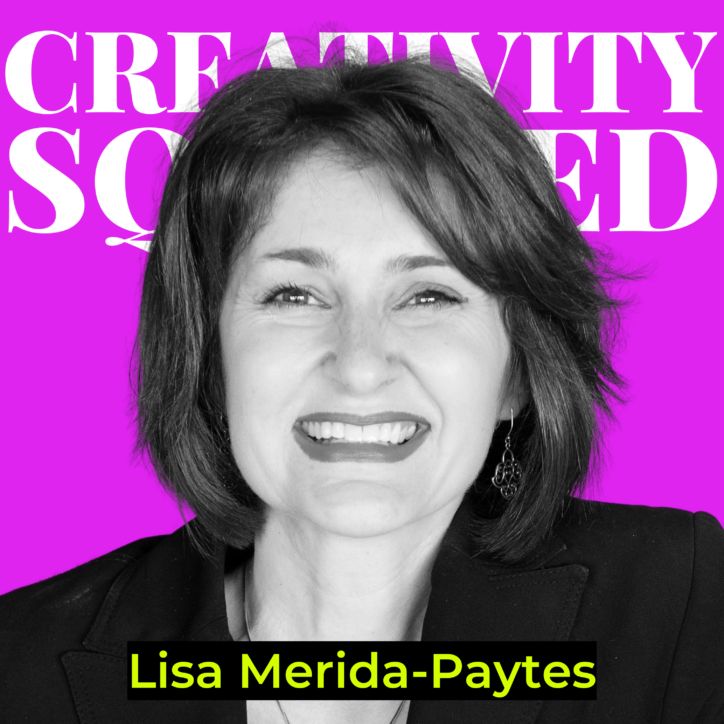
Inspired by the artist’s Hispanic cultural heritage, “Flow:Flux” is a collaborative, woven installation. Made from studio work, it incorporates paper elements constructed by the community in artist-led workshops. The project will combine innovative materials and processes and embrace the possibilities of alternative installation strategies, challenging the plinth and pedestal.
Meet Lisa Merida-Paytes, a Hispanic artist with disabilities caused from Spinocerebellar Ataxia, a rare neurological disease that is progressive, affecting her ability to walk, talk, balance and use fine motor skills, her artwork not only considers the essential structure of skeletal or embryonic animal references but has become a vehicle to interpret transformative changes occurring in her body caused from the progression of the disease. Also, her work researches and brings awareness people living with disabilities while pushing the boundaries of contemporary art. Her work discusses these concepts by focusing on movement’s copious flow, a manner of passage of the living body to one’s gait and gesture. This work drives examination and permits curiosity uncovering aspects of human nature and wonder of origin. These juxtaposed ideas reveal blurred distinctions between connections and dysfunction exhibited in multi-media multivalent invocations of the body.
“Mother’s Tongue” by Emily Hanako Momohara
“The idea of truth and innovation is really interesting in the context of Black and Brown artists because we have always had to innovate to be a part of mainstream culture. “
– Emily Hanako Momohara


Mother’s Tongue is a three-piece exhibition that integrates traditional Japanese language with contemporary American landscapes, illuminating a rarely discussed diasporic middle ground. Each piece takes the form of photographic sculptures, wrapped in photographs of American landscapes that share characteristics of Japan. The works explore the deconstruction and forgetting of traditional language, contrasting it with the contemporary construction of identity. Viewers will contemplate the intricacies of the artwork and relate it to their own reflections on language and place.
Meet Emily Hanako Momohara, who was born in Seattle, Washington where she grew up in a mixed race family. Her work centers around issues of heritage multiculturalism, immigration and social justice. Momohara has exhibited nationally, most notably at the Japanese American National Museum in a two-person show titled Sugar|Islands. She has been a visiting artist at several residency programs including the Center for Photography at Woodstock, Headlands Center for the Arts, Fine Arts Work Center and Red Gate Gallery Beijing. In 2015, her work was included in the Chongqing Photography and Video Biennial. Momohara has created socially driven billboards for For Freedoms and United Photo Industries. She lives and works in Cincinnati where she serves as the Interim Studio Arts Chair, a Professor and heads the photography major at the Art Academy of Cincinnati.
“PatchWORK” by Sarah Rodriguez
“So I work a lot with collage, paper cut collage, and because of my background in art education, I really think about how do we tell each other stories as well as our our own?”
– Sarah Rodriguez
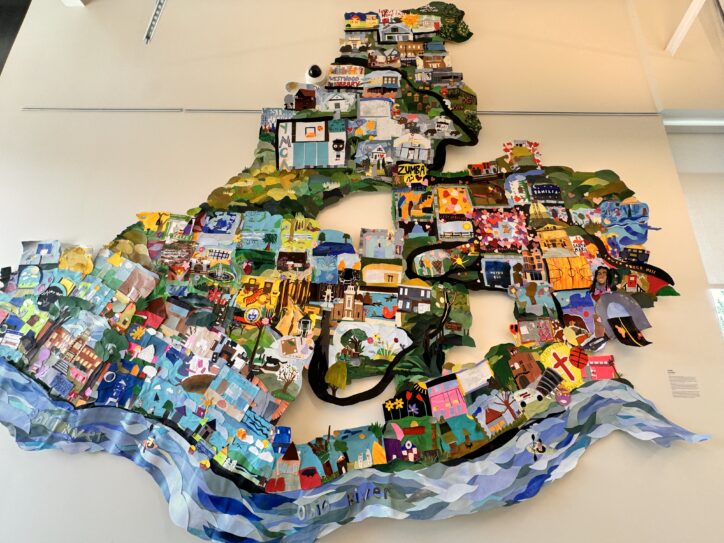
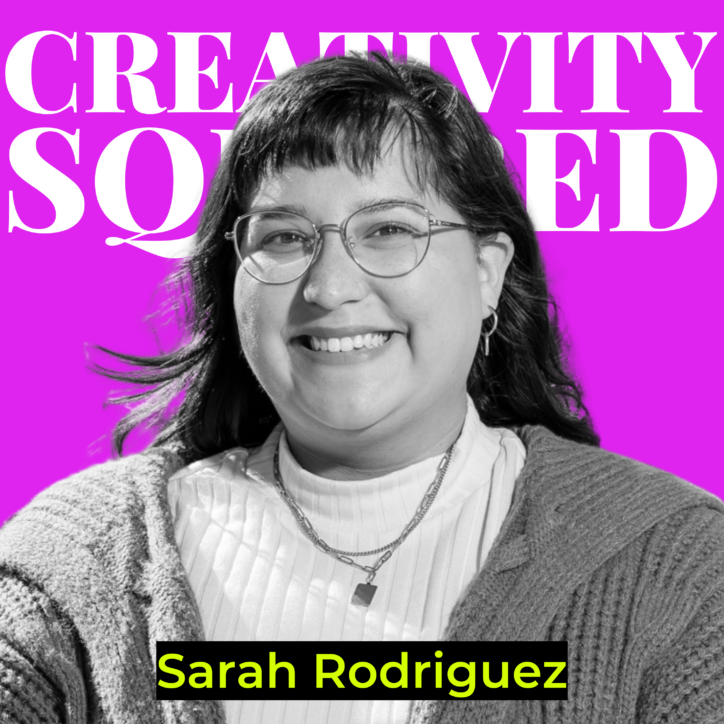
PatchWORK is a large-scale paper collage that combines the work of community members created through a four-part workshop series. Focusing on the west side neighborhoods of Price Hill, Sedamsville, Riverside, Sayler Park, Delhi Township and Westwood/Cheviot, the final collage incorporates imagery from the neighborhoods that make them unique.
Meet Sarah Rodriguez, a multimedia artist and art educator in Cincinnati, OH. Using floral motifs, patterns, and realism her work studies the intrinsic dynamics of the natural world and human experience. She received her M.F.A from Miami University (2017) and B.F.A from Wright State University (2014). She is currently the Director of Education at Kennedy Heights Arts Center (2022-present) and recipient of The ArtsWave Black and Brown Program: Truth & Innovation Grant (2024). She has completed residencies at The School of Art, Chautauqua Institute, NY (2014), Contemporary Arts Center, OH (2019-2020) and V2 Gallery, ArtWorks, OH (2023-2024).
Support Artists and Stay Tuned for More
If you’re interested in working with, featuring, or supporting these artists, please don’t be shy about it.
The next episode in this series spotlights the filmmaker artists of the showcase in Part 2 followed by Part 3 with the live performance artists.

Continue the Conversation
Thank you to all of the artists for being our guest on Creativity Squared. Visit artswave.org/truth to learn more about this year’s artists and showcase.
This show is produced and made possible by the team at PLAY Audio Agency: https://playaudioagency.com.
Creativity Squared is brought to you by Sociality Squared, a social media agency who understands the magic of bringing people together around what they value and love: https://socialitysquared.com.
Because it’s important to support artists, 10% of all revenue Creativity Squared generates will go to ArtsWave, a nationally recognized non-profit that supports over 150 arts organizations, projects, and independent artists.
Join Creativity Squared’s free weekly newsletter and become a premium supporter here.
TRANSCRIPT
[00:00:00] Tatiana: And something that the grant has enabled us to do is to put dollars specifically in the pockets of BIPOC artists in the city and that’s been wonderful.
[00:00:16] Helen: Welcome to Creativity Squared. Discover how creatives are collaborating with artificial intelligence in your inbox, on YouTube, and on your preferred podcast platform. Hi, I’m Helen Todd, your host, and I’m so excited to have you join the weekly conversations I’m having with amazing pioneers in this space.
[00:00:34] Helen: The intention of these conversations is to ignite our collective imagination at the intersection of AI and creativity to envision a world where artists thrive.
[00:00:50] Helen: For the second year in a row, Creativity Squared is proud to partner with ArtsWave to amplify the phenomenal artists and grant recipients selected for this year’s ArtsWave Black and Brown Artist Program. Today, enjoy part one of a three part special series of interviews with the artists featured in the program’s Truth and Innovation Artist Showcase, you’ll hear about their work, the world they want to live in, and their truth expressed through their art.
[00:01:22] Emily: My name is Emily Hanako Momohara.
[00:01:24] Ingrid: My name is Ingrid Woode.
[00:01:26] Faith: My name is Faith Marie Lewis.
[00:01:28] Gauravi: My name is Gauravi Shah.
[00:01:30] Tatiana: My name is Tatiana Godfrey.
[00:01:32] Lisa: My name is Lisa Merida-Paytes.
[00:01:35] Sarah: My name is Sarah Rodriguez.
[00:01:37] Helen: The showcase’s “Visual Arts Exhibition” is open through August 8 at the Clifton Cultural Arts Center. The “Be Still” city-wide augmented reality portrait exhibition is available to experience through September 22.
[00:01:52] Helen: The sketch comedy variety show, “Up the As*pirin: Pain Management,” takes place this coming Friday, July 26, and Saturday, July 27, at the Know Theatre of Cincinnati. For more information and the full video versions of these conversations, visit CreativitySquared.com. From episode nine on the show, Janice Liebenberg, who served as the vice president of Equitable Arts Advancement at ArtsWave shared:
[00:02:21] Janice: And so a blueprint for collective action includes that the arts bridge cultural divides and that is, you know, so key for us as we invest in the arts and how we schedule our programming and how we just feel that the arts can bring people together.
[00:02:40] Janice: No matter what divides us outside of the arts, the arts can bring us together.
[00:02:46] Helen: Creativity Squared is a proud partner of ArtsWave, and because it’s important to support artists, 10 percent of all revenue Creativity Squared generates goes to ArtsWave, which is a nationally recognized nonprofit that supports over 150 arts organizations, projects, and independent artists.
[00:03:07] Helen: This year’s theme is truth and innovation, and I had the great honor of interviewing the artists on what the theme means to them. I’m inspired, humbled, and grateful to share their stories with you. The intention of these interviews is to give these talented artists, another platform to share their art and the truth expressed through it.
[00:03:29] Helen: As you never know what ripples will turn into waves. If you’re interested in working with, featuring, or supporting these artists, please don’t be shy about it. With that, here are the vignettes of our conversations. Enjoy.
[00:03:49] Gauravi: My name is Gauravi Shah. In my day job, I’m an engineer and I work in “Up the As*pirin: Pain Management,” for sustainability. In my evening work, I am a comedian, an improviser, and sketch comedian, and, I am an ArtsWave Black and Brown grant recipient for the Truth and Innovation Showcase of 2024.
[00:04:09] Tatiana: My name is Tatiana Godfrey. I am a co-producer of the sketch comedy show.
[00:04:14] Tatiana: “Up the As*pirin: Pain Management.” We received a black and brown artist grant to do this. In my day job. I’m the literary manager at the Cincinnati Playhouse in the park. I read plays for a living and also another job that I have is comedy. I’d consider myself a professional comedian.
[00:04:34] Gauravi: So our sketch comedy show is called “Up the As*pirin: Pain Management.”
[00:04:40] Gauravi: It is a comedic, light hearted, yet hard hitting show, kind of going through the experiences of people of color through the American healthcare system, and kind of hitting on topics such as, health insurance, to poverty, to, you know, just to, to struggling on waiting lists, to drug addiction and rehab.
[00:05:04] Gauravi: It kind of hits all of these really, serious topics, but in as comedic a tone as we were able to do.
[00:05:12] Tatiana: Yeah, there’s some things that are pretty hard hitting. That’s something that we really wanted to take seriously. The idea of if you’re a person of color, and you’re going through the medical system, things can be difficult, but also some of the things are just silly and stupid.
[00:05:27] Tatiana: And I think there’s a nice balance of both of those.
[00:05:30] Gauravi: So I was a grant recipient of the same grant in 2020, leading to the 2021 showcase, and that theme was Truth and Reconciliation. So we created a show called “Truth and Sketch Conciliation.” Very creative name, I know. But, that was a comedic show. I wanted to do that sort of same structure again.
[00:05:51] Gauravi: And this time I decided to partner with Tatiana. She was part of the previous show, but this time we’re co-producers, because of her writing expertise and expertise in the theater space. So working together has been fantastic. We do have a group of eight people together, and we’re working to put this sketch comedy show.
[00:06:09] Gauravi: It’s written and produced by all eight people together. So in terms of the components of the show, it is just, it’s about 30 different sketches, including some musical numbers, including some short pieces, some longer pieces, just all comedic pieces put together. So that’s why we call it a sketch variety show because it is a variety of different sketches.
[00:06:29] Gauravi: But if you’ve watched something like Saturday Night Live, it’s very similar to that. It’s just played live on a stage. The other thing I quickly want to add is, it’s been great to come together and work and partner with some of our local theaters as well. We had a run in May at the Falcon Theater in Newport that was fantastic.
[00:06:46] Gauravi: And we’re doing it again as part of the showcase at the Know Theater.
[00:06:49] Tatiana: Sketch comedy is really where it lies. Some of them are musical parodies. I’m a big proponent of that. Part of my job was making sure that we had the people who are on board. We reached out to actors and funny people who are local, who are also BIPOC and who we know would do a great job in generating scripts, generating sketches, and then putting them on their feet.
[00:07:12] Tatiana: So we not only wrote all of them, but we’re performing all of these two amongst the eight of us and something that the grant has enabled us to do is to put dollars specifically in the pockets of BIPOC artists in the city and that’s been wonderful.
[00:07:26] Gauravi: So what I was told when I got the briefing from the grant providers is it’s truth and innovation with a focus on health care and the health care system in the United States. The repercussions of the pandemic, kind of going into what does health care mean for people of color and how do we make health care equitable to all of us?
[00:07:44] Gauravi: And that’s kind of what I took from truth and innovation. We have a lot of new developments happening in health care. For example, AI is being used all the time. You know, there’s a lot of consequences of new innovation specifically to people of color. For example, AI is known to be discriminatory at this point.
[00:08:02] Gauravi: based on who you are and what you look like. And so we just wanted to kind of dig into some of those points and say, Hey, not only the healthcare system, but also where’s the healthcare system going towards in the future and how does that continue to impact people of color?
[00:08:18] Tatiana: Yeah. Something that we talked very frankly about in the room is this grief
[00:08:24] Tatiana: that is across the entire world for lots of various reasons, various wars… A lot because of the pandemic on how we’re just sort of holding it in our bodies. And there is no way to come together as a group of people, a group of humans and to be like, Hey, this grief is living in our body and it needs to be dealt with and it needs to be addressed.
[00:08:48] Tatiana: And I’m not saying that our, show is doing that, but it’s definitely a step in the right direction to get BIPOC people together in a room to be creative. That’s the first part, but also inviting audiences in to say, Hey, these are things that are here. They’re real. They’re in our body and the systems that exist are not making them easier for us.
[00:09:08] Tatiana: but we’re going to talk about them and we’re going to laugh about it because it’s a lot easier than crying.
[00:09:14] Gauravi: So I started my comedy journey in improv comedy, improvisational comedy at The Second City in Toronto. And, I just absolutely love the “yes, and” approach of improv, kind of taking what things are and adding something to it to enhance the meaning of it and to take it further.
[00:09:31] Gauravi: So that “yes, and” is the tenet I live my whole life with. So that’s what I love about improv specifically. In sketch comedy, what I really like is the ability to really make people go, you know, to gasp, to take it in and be like, Oh wow, they’re really making a huge point. But then laugh about it, but then go home and say, Whoa, they made me think.
[00:09:52] Gauravi: but I laughed through it, so you know, maybe I can make an impact, maybe I can be impactful because it’s not so serious. It’s not so daunting. And I love the ability of comedy to be hitting on truth without making it seem preachy, without it seeming like, Hey, you have to go and solve all this, all this tension that you’ve put on our heads.
[00:10:10] Gauravi: So I love that role of comedy, and that’s why I keep doing shows like this, because it helps, just frame serious issues in a way that’s digestible to everybody.
[00:10:19] Tatiana: Yeah, my start was probably also improv. First had like a serious improv class, in acting school at NYU, years ago. And my improv teacher is still a writing partner.
[00:10:33] Tatiana: His name is Josh Lewis and we’ve had a lot of serious conversations and not so serious conversations over the years about like the role of comedy and theater, but I’m also like a dramaturg. I’m a theater person and I think about good storytelling. and so I’m approaching from a place of character development because audiences empathize with characters that they, know and recognize and they see themselves in, I’m thinking about relationships.
[00:11:00] Tatiana: Yeah, there’s some, like, spectacle. That’s a theatrical thing that perhaps maybe we don’t have a lot of conversations about in comedy. So both a comedy lens, but also very much a theater lens that I’m bringing to putting together a show.
[00:11:14] Gauravi: I have one particular sketch that I wrote. It’s about a brown woman with Indian parents whose whole life is about getting validation from her parents.
[00:11:25] Gauravi: And I feel like I wrote that sketch very true to my heart. It’s funny because my parents were, they came and saw the first version of it and they laughed as hard as I did. But that’s my truth is that, you know, there’s so many, you know, different experiences of each different person of color. So being a person of color is obviously not a monolith.
[00:11:43] Gauravi: My experiences are totally different from Tatiana’s. And that’s my truth that kind of comes through this show.
[00:11:48] Tatiana: Yeah, I’m a black presenting person who is also Puerto Rican. And I have a character that is very much based on my Puerto Rican grandmother who has this thick Puerto Rican accent and uses folk remedies.
[00:12:03] Tatiana: I think I called the sketch “Puerto Rican Doctor,” but that’s definitely like pulling from my mother, Lillian, her mother, Dona Luz Perez, and, my great grandmother, Maria Guzman. That’s definitely me paying with love, homage to maybe a not so apparent part of my history and family.
[00:12:22] Gauravi: Yeah, I want people to realize that equity in health care is something that is achievable and something that we should constantly keep working towards.
[00:12:30] Gauravi: I also just want people to walk away with empathy and making sure that they’re able to treat everybody around them with compassion. And I think that’s really what I want them to go with and also just laugh and have a good time.
[00:12:42] Tatiana: Taking away some laughter, being funny. You know, I think putting a bunch of BIPOC people on stage is a radical act and that we’re being centered and being seen, like that’s what I hope that people are taking away from it.
[00:12:54] Tatiana: That they’re being seen in that, our experiences are being heard and seen as well, but if they laugh a lot, that’s, good. It’s a funny show. It’s funny.
[00:13:08] Ingrid: My name is Ingrid Wood. I am born and raised in Cincinnati, Ohio. I moved away from here for a little while. About five years for college, five or six years. But I’m back in Cincinnati. So I’m based out of Cincinnati, Ohio. I graduated from school and worked as a chemist for seven years. But I, that whole entire time, I knew going into my interview there right out of college that, you know, my goal was for a production company.
[00:13:37] Ingrid: So I am a musician and a creative producer, so I write and produce music, but also as a creative producer, I take ideas. And use whatever tools that are necessary or other tools that I may need to resource and, create a tangible thing out of an idea that’s in the head. So that may look like an album, a song, a documentary, but it’s primarily visual and audio based works.
[00:14:07] Ingrid: And most recently I, received a grant through ArtsWave, the Black and Brown Artist Grant. And I recently finished up a project that is being exhibited, around the city, really, technically. That’s thanks to a grant through ArtsWave. I’m a classically trained musician. I was playing in orchestras when I was a child, all the way up until I graduated for college.
[00:14:34] Ingrid: I was making money as a kid playing for weddings and things like that. So, but I’m a soul musician. So for instance, like some of the artist, per se, that I’ve written and produced for is Layla Hathaway, which is the daughter of Donny Hathaway, if anybody’s familiar with him. The Cincinnati Symphony Orchestra has performed one of my pieces, so it’s it’s a culmination of everything that I’ve been exposed to directly and indirectly, genetically.
[00:14:58] Ingrid: My mother’s a musician. And visually, you know, as a storyteller, the genre is really documentary like, even for client based work, whether it’s a commercial or a series, it always has that feel of storytelling from, like, a documentary standpoint. Even if it’s a 30 second commercial, it always has that real life documentary storytelling type of feel.
[00:15:21] Ingrid: I have a project, it’s called “Be Still.” It’s a multi medium portrait series project. I’ve received a grant through ArtsWave to be able to execute that project. One of the mediums is photographic portraits. I took those portraits on a film camera. So I, it’s photographic portraits. There is a video series that comes out Wednesday, July 17th.
[00:15:44] Ingrid: 2024, depending on when people are listening to this. There’s a music score that I pieced to score the entire series, it’s a vibe for the series, and then there’s the tech side. So with the tech side, I’ve built the portraits into 3d forms. I work a lot in 3d also. So I’ve taken their portraits, built them into 3d and I placed them into a VR gallery that I built and then also augmented reality.
[00:16:11] Ingrid: So the portraits, people can have fun with augmented reality. So if you’re in Cincinnati or come to Cincinnati up to August 8th, 2024, there’ll probably be, in different galleries and places after that. But, there’s augmented reality piece where you can have fun with the physical portraits in the gallery.
[00:16:28] Ingrid: That one is image specific, so you click a link and it has to be over that specific portrait and it will come to life. Something will come out actually for you to see and have fun with. And then around the city, I’ve basically taken those portraits and placed them in really cool spots around the city, popular parks, museums.
[00:16:45] Ingrid: We have a place called The Banks in Cincinnati, but just a lot of different places around the city of Cincinnati where it’s location specific. So you have to be in a specific location. You click a link on my website and the augmented reality, that digital layer will come up in your real life layer. And you’ll be able to have fun with the portraits and it’s all with your phone.
[00:17:02] Ingrid: You can tap on different things and hear people’s stories. You’ll see the, it’s a whole experience. I don’t want to give it away for people to be able to have fun with when it comes up on their phone. But, yeah, so once again, it’s the photographic portraits, the video series, the tech side with the VR and the AR, and then I have a song that I’ve composed that just kind of is like a vibe for the whole series musically.
[00:17:25] Ingrid: I’m a musician first and, what I’ve learned as a musician and in telling stories that like, I don’t call myself a pianist, I don’t call myself a videographer or those type of things. They’re tools that I use to execute ideas. I’m always going to be musician first. That’s what I’ve been the longest.
[00:17:45] Ingrid: But in the art of storytelling, it’s whatever I need to use tool-wise to make that idea a tangible one. And so across my span of really like, I guess, 15 years of being a full fledged adult and a creative my entire life, some mediums I’ve picked up out of necessity, you know, I didn’t have the resources, so I had to learn how to do it.
[00:18:05] Ingrid: And then some things I just really took a liking to and I, you know, I already developed those things. So I say that to say, you know, as a musician, I look at things, how to involve like different textures. You have different instruments, you have different genres. There’s just a lot of different textures.
[00:18:23] Ingrid: And so I always, when I’m working on projects, it’s like, what texture does this need? And so I wanted to take a story that I was really living through. I had my own be still moment. So right when everybody got done with the pandemic, I had an injury and an illness that happened all at the same time towards the end of 2020.
[00:18:41] Ingrid: And so I spent all of 2021, pretty much bedridden, surgeries, a pain management team at UC, it was a year. And then, the following year in 2022, I had to take that whole year with physical therapy to get my body, you know, back, moving the way it should. But physically, I just, I wasn’t able to create, I wasn’t able to do music.
[00:19:03] Ingrid: I wasn’t able to do a lot of the things that I, you know, wanted to do cause I wasn’t able to sit or stand for really 20 minutes at a time. But in that process, I had been wanting to do this “Be Still” project before that, actually. And so I spent a lot of my time thinking about it. And when I got to a place where I was able to do that, I went on ahead and started it.
[00:19:22] Ingrid: But I’m featuring eight different people in the city. Just a few, like one is an Olympic gold medalist. One is a past writer for CNN. Another is a well known coffee shop owner here in the city who helps a lot of entrepreneurs. But, I am featuring their stories about their own be still moments. These moments where we realize we are not in control of the outcome the way we thought that we were.
[00:19:42] Ingrid: And we have to really just learn to embrace the process of what’s happening to get through it, rather than figuring out how can I get outta this? You realize I have to get through this and you are a better person at the end of it. And so, you know, that’s what I wanted to take that idea and not make art out of the people, but I wanted to take that idea and do it in an artistic way to really promote mental and emotional health.
[00:20:06] Ingrid: Cause that’s a lot of what it’s about. Cause you can go crazy in moments like that. And when you feel like you’ve hit rock bottom for something that wasn’t even, you know, your fault, there’s a lot to build back from that. And so in those be still moments, I just want people to realize that we are all actually probably going to experience those at different stages of life.
[00:20:24] Ingrid: And so this is really an artistic way to promote dialogue around that and to feature people’s stories who you would think like, you know, wow, they’ve gone through something or how did they get through that? Because like I said, everybody goes through difficult moments. A be still moment for me is those moments where we are in a situation where I’m like, how can I get out of this?
[00:20:46] Ingrid: How can I control this? And you realize I’m not in control of it the way that I thought that I was. And you have to learn to let go and just be a part of that process and find the learning points. For me, you know, it’s faith. I had to gravitate a lot towards my faith to get through that and realize that what I am experiencing in the moment is not going to be a forever thing.
[00:21:11] Ingrid: I had to believe that and I had to really work through it. But you have to take that time to really be still in a “be still” moment and allow life to take its course. It’s kind of like the ride the wave rather than going against it. Cause you can, you could kill yourself trying to go against the wave.
[00:21:26] Ingrid: But if you learn to go with the wave, you will eventually, you know, make it back to the shore. And in day and age like today, like I’m very much into technology. I know people are, they think AI is a new thing and AI has been around for a very long time. I think because everything is so quick, I think it’s important to immerse yourself because people, you know, we, flick through things, we scroll through things so fast.
[00:21:50] Ingrid: And so I wanted to find a way to get people to immerse themselves in what the story is rather than just letting it be a picture or whatever it may be. And so I challenge people to, to immerse yourself in the things that you are witnessing and seeing. And I also challenge, you know, creatives to find ways to immerse the public in what it is that you’re doing as well.
[00:22:14] Ingrid: With ArtsWave, you know, our projects were centered around truth and innovation. And when you are really dealing with a reality, you have to be truthful in that moment. And, you have to really face the truth. You know, we are in a world where we put on filters, where we put our highlight reels out for the public to see.
[00:22:35] Ingrid: And it’s, important to really stare at the truth and to be transparent with the truth. And in terms of innovation, what are those innovative things that you can do to have this experience, you know? And so for me, again, it wasn’t just looking at a picture, or hearing a song. It was like, how can I get the people, how can I get the public involved in this story and in a story that.
[00:22:58] Ingrid: We all really experience it one way or the other.
[00:23:05] Faith: My name is Faith Marie Lewis. I’m from Dayton, Ohio, and I reside in Cincinnati, Ohio. I’m a recipient of the Black and Brown Artists Grant for the year 2024. And my project was the HeartSpace Poetry Project. So the HeartSpace Poetry Project is an initiative to engage communities creatively, particularly communities that are black and brown.
[00:23:27] Faith: And this is to inspire conversations and to create mental health support networks. So it started as a way of wanting to help people be able to express themselves and create dialogue about some of the social issues, but also triumphs that we experience in our day to day lives, whether it’s on an individual level or a political societal level.
[00:23:46] Faith: And so this project came into fruition during the ArtsWave Grant Project by allowing me to work with a group of teenage black girls within the Cincinnati region and help give them a platform in order to share their poetry. And so a lot of the things, for example, focused on their experiences within girlhood, their experiences, as far as their sexuality, their experiences with their bodies, the being policed, mental health, their identities, and so on and so forth.
[00:24:17] Faith: So, it was really empowering to be able to help create that space for these young women to be able to express themselves and to watch their community show up for them. At the end of it, we had three winners and these winners will go on to work on other projects within the city with other poetry professionals who were present as well.
[00:24:35] Faith: And so after working on that aspect of the project, it kind of culminated into a visual piece where I wanted to take some of those themes that cropped up during, the poetry performances, but also as my own experience, because a large part of it was about the expression of anger and emotions in which a lot of girls and women, particularly, black girls and women are taught is inappropriate and aggressive.
[00:25:02] Faith: And as a masculine trait that’s not valuable within women and feminine people. And so it was important for me to be able to show that within rage, there’s also compassion. There’s also a place for advocacy. There’s a place for change. And I wanted to communicate that not only through the heart space poetry project, by providing a space for these girls to share their stories, but also within the final piece by kind of culminating some of the written pieces by black women who have inspired me.
[00:25:30] Faith: Such as Maya Angelou, Brittany Cooper, who wrote “Eloquent Rage” and then there was also another writer called, Saraya Chomette (Soraya Chemaly) as well, if I remember her name correctly, who wrote “Rage Becomes Her,” which is the name of the final piece, which is actually a work in progress. So I’m looking forward to building upon it.
[00:25:48] Faith: And I think that’s one of the things about anger is that when we analyze it more and more, we get to find different, kind of roots and pathways on what’s influencing our emotional response. And it allows us to build kind of like a bigger, more specific picture of our emotional body rather than just the initial reaction, which is what a lot of people tend to pay attention to rather than, the core of what’s going on.
[00:26:12] Faith: The final exhibition, I’m excited because it took a little brainpower for me to decide how I was going to show this visually because poetry is a very oral kind of art form. And so, the first thing I did was go to this like, fabric store. And I’m just looking at all these different kinds of fabric.
[00:26:31] Faith: And so that’s one of the main kind of aspects of the visual work is that it uses fabric because I wanted to, once again, touch on these different textures, these different kinds of backgrounds and these different kinds of like, like cotton, like linen and canvas, and really kind of bring to life that different, the way that emotions can be varied, you know, whether it’s smooth or rough or bumpy or.
[00:26:58] Faith: So, but the canvas looks like itself. It has, it’s believe 30 by 34, but it has a stretch of fabric pulled over it as the background. And it has like images of trees. And if you look closely, there’s like little foxes running through the background, right? Cause foxes are very like, sly. And then on top of it, there’s an image of a black woman made of my likeness, right?
[00:27:22] Faith: Cause I like to do self portraits. I think it’s a great way to inspire introspection and, within this figure, you know, from the head up, you, it’s kind of like a portrait from the body. From the shoulders down she’s wearing all black, but she’s kind of like very exposed at the same time. So she’s not covered at all.
[00:27:40] Faith: And she’s kind of rising out of these flames, right? And the source of these flames are the police cars that are surrounding her. And then on top of her head, there’s a head wrap that I made out of canvas and different forms, kinds of like cotton fabrics that has a basket like tomatoes. I wanted it to look like a basket of tomatoes.
[00:27:58] Faith: Cause when people are rioting or protesting or expressing distaste, you know, they throw tomatoes, like “boo, tomato, tomato.” And I love that. And I said that the entire time I was making it. And so it’s just supposed to show this dissatisfaction with the way that things are, the way that things have been with state and police violence against black people, which extends back right to 1619, as well as just this ability to show like, okay, anger has its place.
[00:28:25] Faith: It has its place within black women and in the female body. It has its place within our society and our anger like matters and it can bring change and it doesn’t necessarily have to be palatable or ladylike, right? It can be like, she’s like very demure with the way she’s like kind of looking like this, right?
[00:28:43] Faith: But all around her, there’s like these flames and tomatoes and there’s so many other elements I’m looking forward to adding to it to build upon it that I think is going to really enrich just what it looks like. For what I want to add to it, if you’re familiar with Kali Ma, she’s a Hindu goddess that has a lot to do with like creation, destruction, [and] when you see this image of her, it’s like, she’s kind of like badass, to be honest.
[00:29:11] Faith: Like she has multiple arms, she’s holding swords, and it’s not necessarily that, And she’s actually like very revered, you know, in this culture, across cultures, really, even people outside of the Hindu religion look at Kali Ma as a symbol of like just feminine empowerment, feminine rage, you know? And so I’m not, you know, the most schooled, right.
[00:29:32] Faith: in Hindu culture, but one of the writers that once again inspired this project, her name is Soraya Chemaly. She wrote this book called “Rage Becomes Her,” which kind of goes through the experiences of girls and women when it comes to expressing anger and how we internalize it instead, which results in a lot of social injustices, but as well as chronic issues with our health whether it’s physical or mental.
[00:29:56] Faith: And so I was like, okay, that would be great to kind of incorporate like Kali Ma and then, which I want to add other arms to there as well. One of ’em, she’s holding a bolt of lightning. That bolt of lightning is inspired by Oya, who is a Yoruba goddess, from West Africa, who also has roots in other religions and spiritualities of the African diaspora.
[00:30:18] Faith: But she is the goddess of like tornadoes and winds and storms. So also somebody who is very like. connected with being assertive, being, I would say, aggressive, but really, having this, like, kind of rage to her, but also, once again, being, like, revered. So, I want that bolt of lightning. I want those multiple arms.
[00:30:37] Faith: And I’m still thinking about what else is going to be on her hand. Maybe I’ll add another tomato in her hand. And then there’s going to be another poem I hope to inscribe by Maya Angelou. This poem is called “The Mothering Blackness.” Which when I read it, I was like, this is perfect. so I want to incorporate that too, maybe along the borders with some more cloth strips or some like white paint marker to make it have that graffiti feel, to kind of bring some more of that urban touch into it. With the accompanying piece,
[00:31:06] Faith: I made with fabrics which are hung over a room divider that’s made of wood. I really wanted to work with fabric. It’s something that’s been interesting me for a while and it kind of reminds me of like the connection that black people and really the United States has with cotton, right? And how important it’s been to like the, basically the tapestry of our nation, right?
[00:31:28] Faith: And our, also our social relationships and who we are as people. And then I also was thinking about kind of the freedom quilts that are a popular topic amongst like the, when it comes to speaking about the Underground Railroad and whether or not they played the role in helping lead people, enslaved black people to freedom when it came to traveling the Underground Railroad.
[00:31:50] Faith: I wanted to make a quilt. Instead I took these pieces of fabric and onto them I’m trying to transpose, like, different writings. It was poems by myself that I’ve made over the years. There were poems by Maya Angelou, such as, like, “I Know Why a Caged Bird Sings,” “A Mothering Blackness.” There were quotes by Brittney Cooper, who wrote “Eloquent Rage: A Black Woman’s Superpower.”
[00:32:11] Faith: And then there were also, I believe, some quotes from, Soraya Chemaly, as well. And so I kind of hung those over. And really, that’s one of the things is that, if I have been able to do this as a performance piece, I wanted it to look like, a vanity, like a armoire, like somebody’s getting dressed behind this and I’m performing these pieces while you kind of get to see like the painting.
[00:32:32] Faith: And there will be a stool, for example, and then there will be like maybe a basket. I would’ve liked to have like some cotton or clothes in there just to kind of have this bedroom feel where you’re getting this kind of intimate insight as somebody’s processing like their emotions of the day. And I wanted to get like these window frames when you’re looking through the window.
[00:32:50] Faith: there’s another art piece behind there. So ideally I’ll be able to bring it back and have it more full fledged, but that’s what the room divider was for is, one, to be able to showcase those fabrics, but also because it’s starting to build into this desire to have this feel of like anger as an adornment, right?
[00:33:08] Faith: As something that we can wear and show and express in a way that we will wear clothes or the way that we use fashion. It’s just like, what role is it playing? And how do we, like, perceive it, whether it’s hidden behind the divider or out front and personal. My truth that’s expressed through this piece is that I am an angry black woman.
[00:33:28] Faith: I am, and I don’t think that I’m alone in being an angry black woman. I don’t think I’m alone in being an angry woman, an angry feminine person. Whatever, however you identify, I think that a lot of people, especially those who have been assigned female at birth, are taught to suppress the way that they feel.
[00:33:44] Faith: And I did that so long throughout my life that it came to a point in my adulthood where it became harder to regulate my emotions because I realized what I thought was emotional regulation was emotional suppression. And so then it’s like, as an adult having to start that journey of developing this kind of maturity and to be able to look closely at what you’re feeling and to be able to dissect it, I intellectualize a lot, right?
[00:34:07] Faith: But some of the challenge for me is to be able to feel it freely and to be able to do it in a way that’s responsible and where I can remain accountable even in the present moment that I’m feeling it. So that’s why it’s present. I also had interactions with the police as well from a young child, whether it’s being like pulled over with my, like a family member in the car and not, and it was being my first kind of contact with them to watching the videos of Trayvon Martin in the news, you know, around the years that a lot of the black lives matter movement started to grain traction to kind of some of the more current protests with George Floyd and Breonna Taylor and things like that.
[00:34:47] Faith: And then once again, my own experience in which I was, accosted by police on campus after I had been identified as a student at the university, and the situation was escalated, as I was being like, you know, yelled at, and there was, some aggression present that eventually led me to be arrested for trespassing, on a campus that I had been going to for six years after having given permission by staff to be there with my emotional support animal, which had led to that interaction.
[00:35:18] Faith: So. And after that, I just didn’t know what, I felt like it was wrong, right, to express, my anger. I’ve had a few more situations since then where I realized that it’s because I’m a black woman, it’s because I’m a woman, and it’s because I’m black, depending on the situation, right, because this can also happen within communities as well, that we’re police and that we’re expected to contain ourselves when we’re facing an injustice or a discomfort, that we want to advocate against.
[00:35:48] Faith: I feel like some of that within the anger is a fear, right, that our boundaries have been overstepped, that we’re going to have to be on the defensive, and things like that. Or if you want to be an artist, or if you want to be part of a conversation, that there’s an anxiety that you don’t have anything to add, or nobody wants to hear from you.
[00:36:08] Faith: And I just think that kind of approach means that it’ll never change, you know, that those spaces will also always continue to exist. There had to be somebody who was willing to disrupt the status quo, who was willing to disrupt kind of those inner voices that want to contain us and hold us back because that’s what we heard growing up.
[00:36:26] Faith: So I would say do it scared. And I would say own your anger as well and own it in a way that it can make a change the change that you want to see and a change that’s hopefully beneficial for the collective, even if it’s just holding other people accountable for the way that they treat you and the way that they perceive you, and take ownership that at the end of the day, your life, your path is your own.
[00:36:49] Faith: When it comes to being, an angry black woman, right. Who wants to express her anger and encourage other black women and other women of color and people assigned female at birth to really own their emotional body and to express it without worrying about making other people feel uncomfortable. I think it does come with the lightness cause you shed the burden of having those expectations and internalizing them and then weaponizing them against yourself.
[00:37:15] Faith: And it kind of helps create this mindfulness. And so one of the things that I’ve been focusing on, I’ve always been like this. I’ve always been more reserved. I’m the oldest daughter of like six children. So I’ve always been more reserved. I think it’s those moments when I do have to feel my emotions that I find that I need the most balance.
[00:37:32] Faith: And so that comes with me being able to also notice what is like required when… Will my anger, my rage benefit me, right? Because if I’m giving it to somebody who wants to exploit it then it really kind of does nothing for me and I think it does help me go throughout the day where I’m like “that annoys me, but it doesn’t work me up in the way that it used to which is definitely helpful during rush hour traffic.
[00:37:57] Faith: Yeah, it does come with the lightness and it also comes with the frustration because when you start to know better, you have to start to act with a little more accountability for yourself, because you know that you want to express yourself or be a certain way, which can be frustrating, right?
[00:38:13] Faith: Because we’re still human. So yeah, right now I would say because we’re in a space where we’re having like a dialogue and because I could talk about this and I’ve been able to like meditate on it, I’ve been able to kind of really be more open about speaking on anger. It’s not, it’s more fluid and I do kind of feel lighter in my day to day, even though I still frequently, right, have my moments of anger, frustration, crop up.
[00:38:41] Lisa: Hi, my name is Lisa Merida-Paytes and I’m a 2024 ArtsWave Black and Brown recipient. I am a visual artist who’s based in Cincinnati, Ohio. Currently I’m working with mixed media, working a lot with paper; weaving and thatching the paper together, adding a pet de bear techniques of glass and ceramic. Hand building techniques as well.
[00:39:17] Lisa: The pieces are very light and grounded in traditional plain and negative Hispanic weaving techniques. My piece is entitled “Flow:Flux.” for the Arts Wave showcase this year. And, it’s a site specific installation that’s installed at the Clifton Cultural Arts Center. My inspiration for the work came from a recent diagnosis of a genetic disease.
[00:39:54] Lisa: That’s a resemble dominant and it’s, from my father and the Mayo Clinic has traced it back to, done the genealogy and I am seven generations moved Abraham Lincoln’s cousin, this gene is so strong that it has trampled through the generations that far. So the work is really just working through the connectivity and the malfunction of connectedness of different systems talking together or not.
[00:40:41] Lisa: You’ll see in the work that there’s areas that might flow. And other areas that could branch off into the new variation of the design. So that’s where it comes from. When you first get off the elevator at the arts center, you’re confronted with a lower hanging piece that. It’s very confrontational, but then the pieces that are suspended or are, layered together and rising to the ceiling.
[00:41:27] Lisa: So you really, the viewer is really a part of the piece with the shadows that are dissolved in the space and the walls of the ceiling and you can actually touch the work and feel. Some are low enough to touch, some are out of reach. I want the viewers to walk away with feeling inspired. From looking at the work and experiencing the piece, with a feeling of inspiration.
[00:42:05] Lisa: And I want them to find the beauty in growth and decay. And I hope that they will, find the beauty in frailty. I own this disease, I own it, and this platform really allowed me to interpret some of the things that were going on physically with me and interpret that into an artistic aesthetic, that really [has] inspired additional work to come.
[00:42:52] Lisa: I feel like I’ve just begun the series of work and ArtsWave allowed me to do that. This, allowed me to literally create this innovative work and interpret some of the ideas that I was working through on my own. But very hard to digest and also let me tap into the, previous generations of my cultural heritage of weaving techniques into that work. My truth is bringing awareness.
[00:43:42] Lisa: of someone that might be experiencing some sort of malfunction or some metamorphosis in their body or their work or the world. And I really want this work to not only speak about my personal journey, but the connectedness of us all and how we can all work together to create something better. I would like everyone to remember that art is so important.
[00:44:24] Lisa: Visual art, performing arts, they’re so important to our culture. Artists really wear their heart on their sleeve. And, they interpret the world around us that some of us might not see or think about and so it’s so important to continue to get these very, very important voices out for everyone to consider and have an open mind. Growth and decay, for me, is interpreted in this work through the biomorphic shapes that are created by the spines and thatching, the weaving techniques, but then areas might fall apart and create the remnants of what was there.
[00:45:20] Lisa: So a lot of times I’ll walk in the studio and I’ll look at them completely different where I think a piece might be growing. It might look like it’s the remainder of something and almost apparent for what was lived and what was there.
[00:45:46] Emily: Hey, my name is Emily Hanako Momohara and I’m an artist. I’m an educator. I’m a professor of studio arts at the Art Academy of Cincinnati, where I also serve as the head of photography and the interim studio arts chairperson. I am so pleased to be a recipient of the Truth and Innovation grants from ArtsWave.
[00:46:11] Emily: I mainly work in photography, but I do a lot of film and video and sculpture, as my piece is displayed in the gallery at the Clifton Cultural Arts Center is a very sculptural piece that uses photographs. I say I also use quite a bit of collage, I think, in my work as well. The piece that’s in the Arts and Innovation Showcase.
[00:46:36] Emily: for Arts Wave is part of a three piece series called “Mother’s Tongue.” This piece is a word that is Gaman. We don’t really have a word for it, but the title Gaman, if you were to translate it in English, would mean something like silent endurance for your family or for, you know, the good of others. And that term is, used quite a bit in the Japanese American community around the incarceration that happened during World War II.
[00:47:06] Emily: So, 125,000 people on the West Coast were put into camps based on their ethnic background. My grandmother, who was born in the United States, was one of those people, as well as her whole family and my great grandparents who immigrated here from Japan. That idea of enduring is, very prevalent within the community and my family, regarding their experience.
[00:47:34] Emily: The piece that I made is actually the character pulling them apart and looking at the radicals of what those characters mean. I don’t know if the audience understands what referential type of language is, but in, in Japanese, kanji, the characters often are, pictographic, or one character represents a word.
[00:47:59] Emily: So a word can be compiled with a bunch of different characters. So we break apart those characters, and I wrap them all in imagery from the camp of the actual earth. And those characters have fallen into a pile, and they’re sitting on the ground of the gallery. The three pieces that are part of Mother’s Tongue, the first piece, Gamon, is in the exhibition, the showcase, and the other two pieces, one is about the idea of migration, and that piece is going to have imagery of water that is wrapping around those characters.
[00:48:36] Emily: That have kind of fallen apart. And the next one is the one of family. So, and that is actually going to have plant imagery. The idea of like a family tree and they will have fallen, but they’re going to be more leaning up against the wall so that they can have that vertical composition that our bodies, as it’s a human word, family, can represent.
[00:49:02] Emily: The idea of truth and innovation is really interesting in the context of black and brown artists because we have always had to innovate to be a part of mainstream culture. There are aspects like education and the art world, neighborhoods, all, you know, everything that you have to navigate that is not made for you specifically.
[00:49:25] Emily: So, innovation is just, I think part of the way in which we live, or I live specifically. At the reception, it was really interesting. A local curator had said to me, wow, this work is so different. you know, every time I see your work, you’re using photographs in a different way. This idea of the photograph wrapping around.
[00:49:49] Emily: a character in Japanese, right? And having that be a physical form. And I think that’s what art does best, right? Is that it shows us these things that, maybe we didn’t, we can’t conceive of. And it allows us a different entry point into the idea of endurance and, and sacrifice for family or, migration, et cetera, that my work has to do with.
[00:50:16] Emily: I think for me, my truth in this work is the legacy, that I am not the singular entity that, you know, exists in the world, but that I am part of a lineage of people that came before me, who paved the way for me, you know, I’m half Japanese and half mostly British. there’s this British saying on their money that says “standing on the shoulders of giants.”
[00:50:44] Emily: And I feel like I have a lot of giants, that I rely on to create the work that I make. I think that if folks walk away from our conversation and are more curious about different cultures, different segments of the Cincinnati population or the, our country’s population, I think that’s a good thing.
[00:51:08] Emily: I’m bringing to it my specific story, which is probably different from most of our viewers. And so if people are just curious and a little more understanding of each other, that is, that’s my goal.
[00:51:24] Sarah: My name is Sarah Rodriguez. I’m an artist and art educator in the Cincinnati region. I’m currently the academic advisor for the art and design department with the School of the Arts at Northern Kentucky University.
[00:51:35] Sarah: And I’m here to talk about the ArtsWave Black and Brown grant for 2024. So I work a lot with collage, paper cut collage, and because of my background in art education, I really think about, how do we tell each other’s stories as well as our own. And so this piece that I created for the ArtsWave grant was about bringing people together through art and hopes that art can create
[00:52:02] Sarah: a sense of repair in the neighborhoods, across neighborhoods, that oftentimes might have differences, whether that be cultural, racial, economic, and so using art as a tool to build relationships and connection with each other. But in my own work, I often try to think about that, with when I’m doing individual or solo work, and then as well as how we as people connect to each other and nature.
[00:52:28] Sarah: and so in the piece, it’s very landscape based as well. So with the patchwork, piece, it’s a community arts project, and I used large sheets of paper, that were shaped like some of the west side neighborhoods. And that went across Sailor Park, Riverside, Sedamsville, Westwood, Price Hill, and Delhi Township.
[00:52:51] Sarah: And then they were big sheets of paper that were just like the topographical map. And then those, pieces were taken to different workshops in those various neighborhoods. and collaged on top of with lots of different colorful paper. And people were asked to create little vignettes of their favorite places or their favorite people in their neighborhood.
[00:53:12] Sarah: And then after all the workshops were finished, I took the pieces and put them together into one almost tapestry like collage that’s about 14 by 15 feet, really irregular shaped and kind of took on its own kind of An amorphous shape there, that doesn’t necessarily reference the map exactly, but, kind of took its own breath.
[00:53:34] Sarah: And, it’s very colorful and really showcases those individual neighborhoods. And then I individually collaged specific landmarks, to really kind of bring the, and landscape to kind of bring the pieces together. So the inspiration for this piece was my background in art education as well as, I recently, this last, in 2023, did a project with the Cincinnati Children’s Hospital and Kohler Design.
[00:54:05] Sarah: That project was really amazing because I got to take my collage pieces into the hospital and work with patients and their families to collaborate on the pieces. And so kind of a combination of community programming through art education and then that project with the hospital kind of gave me the idea for how I can create this programming with my own work, and my own techniques that I use, but do it on my side of town.
[00:54:32] Sarah: So I’m a westsider, I’m a transplant, but I love the west side. It makes me think of my hometown. And, I wanted to celebrate the people that are my neighbors and get people who are making art, make art and help them be creative, even if they, might not do it all the time. So it was really fun to kind of bring people together in this way and use art as a tool to do that.
[00:54:54] Sarah: So that’s kind of what spurred the idea, is just a love for the west side and making art with people. With this process, it’s really rooted in my own practice of getting these, this love of paper as a material that really is, you know, so basic. Like, I love that art can be just a pencil and a piece of paper, or chalk on a sidewalk, or a rock on a sidewalk.
[00:55:16] Sarah: I love that it can be simple like that. And so, always trying to stick with that simplicity of, paper and collage. And so with my process, I roll out big sheets of paper and I kind of fill it up with fields of color, and then that gets broken down and color coded, very art teacher of me, especially in this, workshops for other people, working with the community and then those little, those kind of sheets of color become little tiny fragments and, these little tiny pieces that, end up making up the whole, and so that kind of is
[00:55:49] Sarah: a metaphor for how I think about our community, community building, and collage really kind of mimics that in a way where it’s all these tiny things that kind of come together to create something greater. And so that’s really what I think about in my own collages and then was just emphasized even more by, incorporating the community and asking people to be a part of this.
[00:56:11] Sarah: And there was such an amazing response to it. And so getting to introduce them to new processes about art and how to think about art as not this like thing that’s untouchable for them, but something that’s very accessible to everybody. Theme being truth and innovation, what I loved about that was, and what spoke to me, was this idea of art being an innovative tool for healing, for repair.
[00:56:40] Sarah: I found that a lot of the artists in the showcase had a lot of health almost, based work, which I thought was really interesting once we all kind of got together. And so for me, I really thought about, again, like community healing. I live in Delhi Township, which is kind of, and all the neighborhoods I focused on are on the west side.
[00:56:59] Sarah: So it kind of borders this space urban and rural and that’s kind of where I grew up to in my hometown, kind of in a little city. It’s not really a city, but a little city and then the country right there too. And so kind of seeing those spaces between, you know, maybe people of more Appalachian descent, people of more black and brown descent, and, that kind of thing.
[00:57:24] Sarah: And so seeing with those neighborhoods and seeing where there’s kind of, you know, like this in a lot of places in Cincinnati, there’s kind of this divide. These divides that happen. And so again, trying to use art as a way as an innovative tool to create connection across those diverse neighborhoods and bring people together through that.
[00:57:43] Sarah: So I love that at the end of this, that people who participated or even just westsiders in general can go up and say, Oh my gosh, I know where that place is. Oh, I love how they did that because I recognize it or I made that one. And so it really creates this back and forth conversation with people who may not have been able to have a conversation before.
[00:58:04] Sarah: So that was kind of the, I think location and place is so important to me in my work that it made sense to do something that really represented the uniqueness and vibrancy of the westside neighborhoods. The one thing I would want people to take away from the piece is knowing that you can be creative, even if you don’t think you are, to not be afraid to talk to your neighbors and organize independentlyto do just fun things too, as well as, you know, if you have initiatives that you want to take.
[00:58:40] Sarah: But that art is really a powerful thing that can bring us together. It’s a very human thing. And, we all have a creative bug, even if we don’t think we do. So don’t be afraid to put yourself out there and, get your hands a little messy. I think my truth that’s expressed through the piece is really, you know, part of my identity.
[00:59:00] Sarah: My dad is from Mexico and my, I grew up in, you know, more rural white Ohio. And so I think that my truth is really the truth of a lot of people. A lot of people in my neighborhood, a lot of people in our country where we come from different backgrounds and that makes us who we are. And so I think my truth with this project is really.
[00:59:24] Sarah: Allowing other people to be expressive, and through that, they allow me to be expressive of myself. And, that we all have, the ability to have these universal things that we love, like drawing a doodle, or these neighborhood spaces that we, can come together. I hope they get a sense of wonder.
[00:59:46] Sarah: I think sometimes like the, west side, you know, it has, you know, people love it so much and, it has so much, a lot of families, like that’s their spot, you know? And I hope that people, it gives people an insight into the west side and they come, like, feel curious about different places and spaces there and people and that they want to come and explore, on our side of town.
[01:00:10] Sarah: but then also that they just, get excited about seeing their city represented or even just a part of it represented in a gallery space because I, love Cincinnati so much. It’s just been such a beautiful home for me and I love the arts community here. So I think, it’s a perfect representation of those two things together.
[01:00:31] Sarah: Oh my goodness, where is the piece going to live after this exhibition? It doesn’t have a home, so if anyone has any ideas, please reach out. I think I would love to keep it on the west side. I think we need a big wall, to really house it. I’ve considered what it would, and I’ve kind of been in conversation with people over the last week, about what it would be like for the piece to be in different places. I work at a university,
[01:00:57] Sarah: so it might be, maybe we can have it in the library for a little bit or we can do, you know, maybe the public library would take it for a little bit. So it could move around, but it also takes funding. So I’m a little bit, you know, unsure of where it will live. Hopefully not rolled up like a burrito in my garage.
[01:01:13] Sarah: That’s the goal, to avoid that. But I would love to see it hanging at a public space where people can enjoy it anytime they want. So again, if anybody has any ideas, I’m open to and flexible to those for sure.
[01:01:30] Helen: Thank you for spending some time with us today. We’re just getting started and would love your support. Subscribe to Creativity Squared on your preferred podcast platform and leave a review. It really helps and I’d love to hear your feedback. What topics are you thinking about and want to dive into more?
[01:01:45] Helen: I invite you to visit CreativitySquared.com to let me know, and while you’re there, be sure to. for our free weekly newsletter so you can easily stay on top of all the latest news at the intersection of AI and creativity. Because it’s so important to support artists, 10 percent of all revenue Creativity Squared generates will go to ArtsWave, a nationally recognized non profit that supports over 100 arts organizations.
[01:02:10] Helen: Become a premium newsletter subscriber or leave a tip on the website to support this project and ArtsWave. And premium newsletter subscribers will receive NFTs of episode coverage and more extras to say thank you for helping bring my dream to life. And a big, big thank you to everyone who’s offered their time, energy, and encouragement and support so far.
[01:02:32] Helen: I really appreciate it from the bottom of my heart. This show is produced and made possible by the team at Play Audio Agency. Until next week, keep creating.
